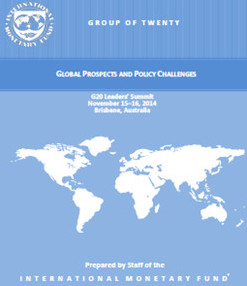Related Links
Group of Twenty IMF Note — G20 Leaders' Summit
IMF Note on Global Prospects and Policy Challenges
November 15–16, 2014
The Following executive summary is from a note by the Staff of the IMF prepared for the November 15–16, 2014 G-20 Leaders' Summit in Brisbane, Australia.
Read the Full text ![]()
Executive Summary
An uneven and brittle global recovery continues, despite setbacks this year. With world growth in 2014H1 worse than expected in the spring, global growth forecasts have been lowered to 3.3 percent for 2014 and to 3.8 percent in 2015. Supportive financial conditions, moderating fiscal consolidation, and strengthening balance sheets should sustain the recovery in the remainder of 2014 and into 2015. Overall, slow growth highlights the importance of G20 commitments to raise global growth.
Key developments since the October WEO include a financial market correction, appreciably lower oil prices, and some further signs of weakness in activity. Sovereign bond yields in advanced economies, which had fallen since the spring, declined further in October. Equity prices, which trended up till late-September, have declined since, notably in emerging economies, where risk spreads have increased. The recent increase in financial market volatility is a reminder of potential risks and potential further corrections. While it is too early to identify the supply and demand factors at play, all else equal, the recent appreciable fall in oil prices, if sustained, will boost growth. Recent data releases also point to weak domestic demand in the euro area.
Downside risks identified in the October WEO remain significant. Heightened geopolitical tensions and potential corrections in financial markets, including due to monetary policy normalization, are the main short-term risks. Other risks are low inflation/deflation in the euro area and low potential growth.
Policy priorities are as follows:
- Advanced economies should keep accommodative monetary policies, given still large output gaps and very low inflation. Reflecting the uneven recovery, challenges are becoming increasingly different across major central banks. While monetary policy normalization will be coming to the forefront in the United States and the United Kingdom, accommodative monetary policy in the euro area and Japan should continue to fight low inflation. To prevent premature monetary tightening, macro-prudential tools to mitigate financial stability risks—for example, in the housing market—should be the first line of defense. Fiscal consolidation should continue to balance fiscal sustainability and growth within credible medium-term plans.
- In emerging economies the focus of macroeconomic policies should remain on rebuilding buffers and addressing vulnerabilities, in preparation for an environment characterized by tighter external financing conditions and higher volatility.
- A higher priority should be placed on growth enhancing structural reforms across G20 economies. Some countries with protracted current account surpluses should focus on boosting domestic demand or modifying its composition. Further labor and product market reforms are needed in much of the euro area. In a number of euro area countries severely affected by the crisis and emerging economies with protracted current account deficits, there is a need for reforms which increase competitiveness, together with wage moderation.
- Finally, in economies with clearly identified needs and economic slack, current conditions are favorable for increasing infrastructure investment. However, while this would support economic development, efficiency of the investment process is important to maximize the growth dividend.
Read the Full text ![]()













